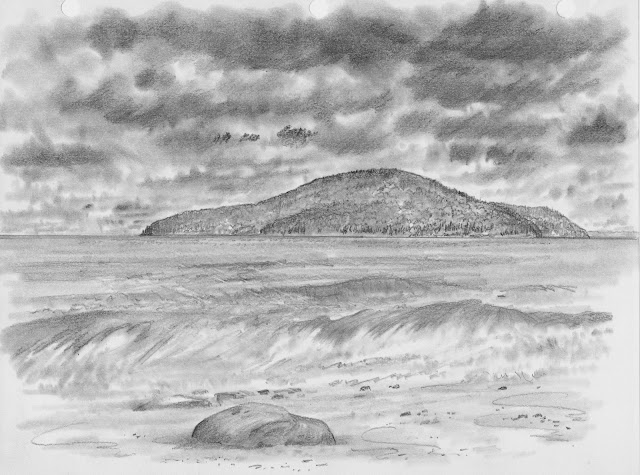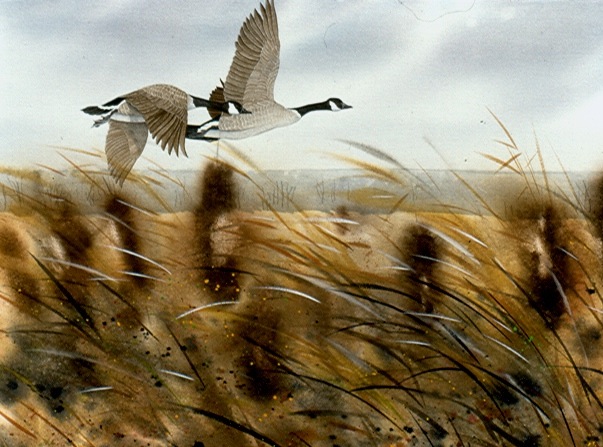 |
"Windswept" Georgian Bay Island Watercolour Field Sketch |
I grew up in Midland, Ontario, located at the south shore of Georgian Bay which is referred to as "The Gateway To The 30,000 Islands”. Actually, depending upon the water level in the Bay there could be fewer, or many more islands. Georgian Bay is large, a side bay of Lake Huron, large enough to be considered the sixth Great Lake, a treacherous body of water when the winds are up. The Group of Seven Canadian Painters made famous the Bay with their depictions of the islands with their wind shaped pines. The Bay has a violent history made more intriguing by the Ojibwa legend of their God Kitchikewana. There exist many variations of the legend. The following are versions found on line written by Bala Menon and Fred Butts:-
The Legend of Kitchikewana - as related by Bala Menon
"Once upon a time, so goes a legend of the Huron Indians of Northern Ontario, there was a giant God by the name of Kitchikewana who stood guard over the whole of Georgian Bay.
The legend says he was a violent god, prone to frequent tantrums - and his size made him a feared figure among the Ouendat (Huron) pantheon. He was taller than two huge mountains (the giant pine trees came only up to his knees) and he wore a necklace of tree stumps, He also wore a headdress which had thousands of bird feathers and his robe was made from 600 beaver pelts.
Kitchikewana was the son of the Great Spirit Manitou. The assembly of Huron Gods one day decided that enough is enough and it was time to get Kitchikewana to calm down. A strategy was devised - the gods will find a suitable consort for Kitchikewana. So they gathered together all the beautiful girls of the surrounding regions. One of them was almost celestial in appearance and Kitchikewana liked her a lot. Her name was Wanakita, daughter of Musquakie, a northern chief, and Kitchikewana proposed to her. Wanakita's reply was a resounding "N0" - to the dismay of the gods. She said she had already given her heart to a warrior in her tribe.
Kitchikewana was shocked - his anger rose and bubbled over. It is said that the earth shook and the skies darkened and the world cowered in fear. Wolves howled in the distance and other wildlife scattered and hid in their dens and in holes deep underground. Not a bird flew in the sky. Kitchikewana slammed the palm of his hand onto the ground - there was a thunderous explosion - and he picked up a massive clump of dirt and threw it in a rage. The dirt scattered and thus was born the the 30,000 Islands. The five finger marks in the ground became the five famous bays of the north - Midland Bay, Penetang Bay, Hog Bay, Sturgeon Bay and Matchedash Bay.
Then, hearbroken and tired, Kitchikewana lay down on the ground and fell into a deep and eternal sleep. Kitchikewana is still in slumber and his massive form is what visitors to the area see as the Giant's Tomb.
A poignant side-tale to the main legend tells of how Kitchikewana accidently killed a girl who liked him - Wahsoona, the daughter of an Indian area chief. The gods then decided that silver birch will be made to grow forever in Wahsoona's memory on Beausoleil Island.
Wanakita married her warrior-lover and later came to Penetanguishene to ask for Kitchikewana's forgiveness. Kitchikewana turned himself into a great pine-filled island. She told the story to her children and they to theirs and the story came down through the generations."
A variation of the Huron legend
"The giant God Kitchi-Kiwana was the last of a race of mega gods. One day, Kitchi-Kiwana fell with a mountain in his arms which then shattered to form the 30 000 islands. The marks which his shoulders left can be seen his favourite island of Beausoleil, which was where he returned to sleep each night. When he died, the natives covered him with trees and rocks to form what is now called Giant's Tomb Island. The flickering Northern Lights (Aurora Borealis) can be seen whenever his spirit visits the islands and the Great God Manitou lights fires to guide him on…"
Kitche'uwa'ne: A Ojibwa (Huron) legend as related by Fred Butts
As Aenons, the Chief of Toanche, approached the assembled villagers, all grew quiet. In the distance a wolf howled as he began to speak.
"Listen now to the howl of the wolf, who calls out to the great Huron Giant, Kitchikewana to wake from his sleep. My children, as many moons ago as there are stars in the night sky, a party of Hunters from Toanche found a baby the size of a man on Manitoulin Island and brought him back here to Penetanguishene, the place of the white rolling sands. They named him Kitchikewana and as time went by, the child grew and soon the great white pine trees came up to his knees and there could be no doubt that this indeed was the son of the great spirit Manitou. Despite his great size, he played with the other young braves, and at the winter games at Ossossane, he could not be beat at fishing, chopping wood and snowshoeing. Every Huron from all five clans knew and respected him and with his presence, the savage Iroquois from the south dared not venture into our lands. It was a time of prosperity. With one finger he could break winter ice for all to fish and he could see and shoot a deer as far away as Ossossane."
"The great Giant could easily find any lost child and once, when a wolf had attacked one, Kitchikewana asked the wolf why he had done such a thing. When the wolf answered that the boy was easy prey, the giant threw the wolf and his brothers to the north in one hand, and to this day their howl recalls this. Finally, when he was a full grown warrior, and he had lost control of his temper three times in one winter, the elders felt that a wife was needed to calm the great one. At the next Ossossane winter gathering, Kitchikewana was invited to pick from amongst the most beautiful Huron women. He picked a girl named Wanakita, daughter of the north Chief Musquakie, but she refused to marry him as her heart belonged to a warrior from her own tribe. Still, she and her father were forced to move to Toanche, on the shores of Penetanguishene Bay."
"For eighteen moons, Kitchikewana tried to win Wanakita's heart and a wedding date was set many times, but each time she cancelled. It was said her heart was ripped from the north and one final time she declared her heart belonged to another, in front of all the Huron tribes. The giant was furious, shamed before all his people. Afraid of his wrath, she and her father fled to the north in a canoe. Seeing this final betrayal, Kitchikewana reached down and threw handfuls of earth at them, capsizing their canoe. Seeing them drowning in the falling debris, the giant plucked Wanakita and Musquakie from below the water's surface, gave them each a kiss of life, put them back in their canoe and pushed them away to their northern home."
"Broken hearted the giant sat out in the waters all summer, refusing all food, drink and visitors. His absence teased the Iroquois into venturing into Huron territory once again. The elders met and sent word for Wanakita, who had since married her own warrior, to come and ask the giant's forgiveness and blessing. Maybe then he would be persuaded to marry one who would have him. But on the night of her arrival here in Penetanguishene, a great storm raged while the giant called out to his father. In the morning, a great pine-filled island was left in place of the giant. Asking for the great one's forgiveness as she kneeled on the beach of the island, a breeze blew and a rainbow broke. She cried and knew she was forgiven. Through the ensuing years she told her children and they theirs, of the great giant and his island that will be forever known on the great bay as "The Giant's Tomb"- the isle of legends."
Aenons crossed his arms and looked down. The great story was finished.
Over the years I’ve made several paintings of the Bay’s islands including the Giant’s Tomb. Hopefully, I’ll find the time to do many more.
 |
Georgian Bay Island Pen & Ink Study 2014 |
 |
Georgian Bay Islands Graphite Drawing 1999 |
 |
Islands Near Killarney Watercolour Painting 2016 |














































